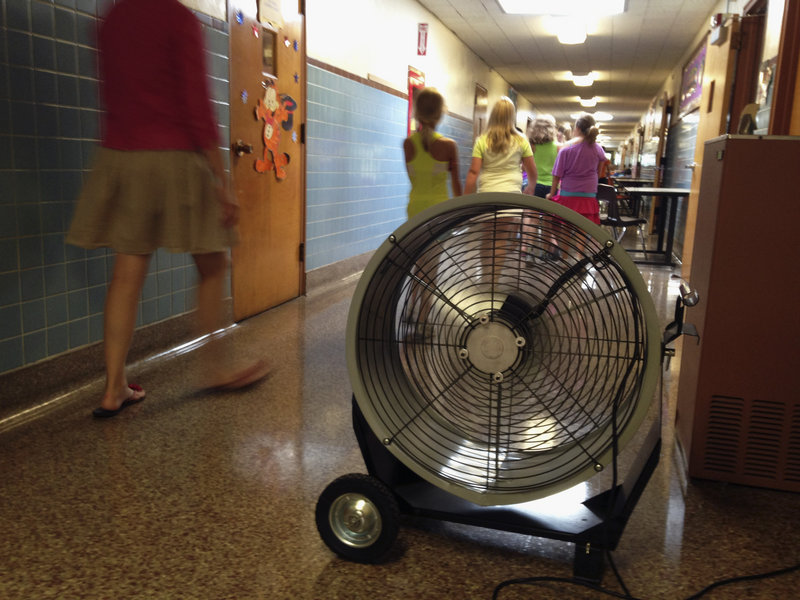CHICAGO – When city students arrived for the first day of school under the blazing temperatures of a Midwest heat wave, staff greeted them with some unusual school supplies: water bottles, fans and wet towels to drape around their necks.
What they couldn’t always offer was air conditioning.
“It’s kind of hard to focus because everyone was sweating,” said Deniyah Jones, a 12-year-old seventh-grader at Nash Elementary School on Chicago’s West Side, which has just a few window units for the entire fortress-like brick and stone building.
This year’s late August heat exposed a tug-of-war in school districts that are under pressure to start school earlier than ever but are unable to pay to equip aging buildings with air conditioning. Parents who worry hot classrooms are a disadvantage for their kids are issuing an ultimatum: Make classes cooler or start the year later.
“Thinking about air conditioning — we can’t even afford new textbooks,” said Bement Community Unit School District Superintendent Sheila Greenwood, who oversees a tiny district of 380 students about 20 miles southwest of Champaign, Ill.
Many people can recall school days spent inside ancient, brick-construction buildings that on sweltering days seemed as hot as pizza ovens. But hot classrooms are becoming a bigger problem for schools than in years past, and increasingly, getting a “heat day” is as common for students as a “snow day.”
As temperatures soared past 90 last week, some Midwest schools gave students extra water and bathroom breaks or canceled after-school activities. Districts from St. Joseph, Mo., and Frankfort, Ind., sent kids home early. In Fargo, N.D., five schools got the week off, and schools in Minneapolis closed down as well.
“I was up on the third floor and it was 93.8 degrees in the classroom and the kids hadn’t been there in hours,” said Matt Patton, superintendent of a one-school district in Baxter, Iowa.
For years, schools have been moving to start the year in late or mid-August rather than just after Labor Day, when it is typically cooler. Part of the reason is that schools need more training days for standardized testing and new academic standards. Holiday breaks have also grown longer, and administrators say the only direction they can go is back into August.
In Chicago, starting a week earlier is part of Mayor Rahm Emanuel’s strategy to improve education in the nation’s third-largest school district by getting students in school longer. Air conditioning isn’t part of that plan.
“The last estimate was over a billion dollars,” said Becky Carroll, a spokeswoman for Chicago’s district of 700 schools. “Those aren’t dollars we have.”
The concerns go beyond comfort. Excessive heat makes the body work harder to maintain the ideal 98.6 temperature, and that can cause people to feel sluggish. Some worry that makes it hard to learn. Sweating helps cool things down, but children sweat less than adults, so heat can affect them more quickly.
Parents are beginning to push back. Sioux City, Iowa, schools decided to move the start of school a week later next year after getting an earful, school board president Mike Krysl said. And a parent group in North Dakota is looking to launch a ballot measure requiring schools to start after Labor Day, said Jeff Schatz, the Fargo school superintendent.
Those measures haven’t always been successful elsewhere.
In Iowa, lawmakers enacted legislation that requires school districts wait until September to open. But the law allows districts to obtain a waiver to start early, and all but 10 of the state’s 346 school districts did just that. Indiana lawmakers have tried unsuccessfully for years to push the start of the school year back to after Labor Day, but have run into resistance from schools who have scheduling concerns and local officials who think the state shouldn’t control the school calendar.
Even in places that have decided to install air conditioning, the process is anything but quick. In St. Joseph, Mo., roughly two thirds of the district schools lack air conditioning, though many will get it in the next two years after the community approved a plan that includes $5 million for air conditioning.
“There was some pushback from people who were saying ‘When we were kids we went to school without air conditioning, why can’t these kids?”‘ said Barbara Moore, the school board president at the time.
Copy the Story Link
Send questions/comments to the editors.




Success. Please wait for the page to reload. If the page does not reload within 5 seconds, please refresh the page.
Enter your email and password to access comments.
Hi, to comment on stories you must . This profile is in addition to your subscription and website login.
Already have a commenting profile? .
Invalid username/password.
Please check your email to confirm and complete your registration.
Only subscribers are eligible to post comments. Please subscribe or login first for digital access. Here’s why.
Use the form below to reset your password. When you've submitted your account email, we will send an email with a reset code.